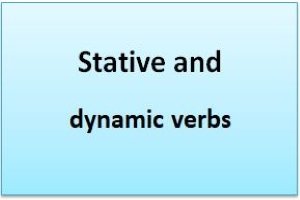Stative and dynamic verbs:
Stative verbs:
are used to describe a state rather than a specific action. In the present continuous form, they are rarely used.
a stative verb (also known as a state verb) is a verb that expresses a state of being. Stative verbs are different from action verbs because they never describe the moving action, like reading, running, eating, and walking. Rather they allude either to immaterial feelings or inanimate states of being.
Stative verbs are frequently associated with:
- Thoughts And Opinions: agree, doubt, believe, etc.
- Feelings And Emotions: love, dislike, like, hate, etc.
- Perceptions: appear, look, feel, see, hear, etc.
- Possession And Measurement: belong, weigh, have, own, etc.
Examples in sentences:
Believe—I do believe in magic.
Feel: She feels alive again.
Weigh: She weighs 100 pounds.
Belong: This book does not belong to me
Dynamic verbs:
are an important part of both everyday conversation and formal writing. They can add clarity and precision to our communication and can also make our writing more interesting and engaging. When used correctly, they can help us better convey our thoughts and experiences to others.
Dynamic verbs are typically used to describe actions that are visible or otherwise perceptible. For example, we can use them to describe someone running, jumping, or dancing. We can also use them to describe someone’s thinking, feeling, speaking, running, jumping, working, playing, eating, or drinking. In each case, the verb conveys information about what the subject is doing.
difference between Stative and dynamic verbs:
|
Dynamic verbs |
Stative verbs |
Mixed verbs |
|
|
|
|
|
To look ( I am looking at him) (Here we are talking about the active process of looking. (I am observing him)
|
1). To play ( I am playing with my friends) 2). To eat ( She was eating lunch with him) 3). To speak (we will be speaking with him later.
|
1). Abstract (To know, To want, To need) 2). Emotion (to love, to hate, to prefer) 3). Possession (to have, to own, to belong)
|
To look (You look happy) Here we are describing a state. (You appear happy) |

